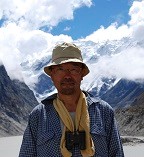NOSHIRO Shuichi
Education
1981–1983 The University of Tokyo, M.A., Forestry.
1983–1985 The University of Tokyo, D.C., Forestry.
1985–1988 Osaka City University, D.C., Biology.
1988 Obtained degree of Dr. Sci. from Osaka City University.
1983–1985 The University of Tokyo, D.C., Forestry.
1985–1988 Osaka City University, D.C., Biology.
1988 Obtained degree of Dr. Sci. from Osaka City University.
Employment
1989–2017: Researcher of Forestry and Forest Products Research Institute, Tsukuba, Japan.
2017–present: Researcher and Professor of Center for Obsidian and Lithic Studies, Meiji University
2017–present: Researcher and Professor of Center for Obsidian and Lithic Studies, Meiji University
Current Research
■Study of prehistoric management and use of plant resources.
■History of introduction and use of lacquer trees in Japan.
■Material selection for prehistoric and historic wooden artifacts in Japan.
■Effect of environmental changes and human impact on forest vegetation in Japan.
■History of introduction and use of lacquer trees in Japan.
■Material selection for prehistoric and historic wooden artifacts in Japan.
■Effect of environmental changes and human impact on forest vegetation in Japan.
Honors
Received the 20th K.Matsushita Foundation of EXPO '90 promotion prize in Dec. 2012, from K.Matsushita Foundation, Japan.
Academic Fellowship and Activities
■Editor of the Japanese Association of Historical Botany, 1983–1998.
■Editor-in-chief of the Japanese Association of Historical Botany, 1998–2015.
■President of the Japanese Association of Historical Botany, 2019–present.
■Associate editor of IAWA Journal, 2018–present.
■Editor-in-chief of the Society of Himalayan Botany, 1988–present.
■Editor-in-chief of the Japanese Association of Historical Botany, 1998–2015.
■President of the Japanese Association of Historical Botany, 2019–present.
■Associate editor of IAWA Journal, 2018–present.
■Editor-in-chief of the Society of Himalayan Botany, 1988–present.
Selected Publications
| 2011 | Noshiro, S., Leng, Q., LePage, B.A., Momohara, A., Nishida, H., Uemura, K., Williams, C.J., Yang, H., eds. Metasequoia: The Legacy of Dr. Shigeru Miki. Proceedings of the Third International Metasequoia Symposium (Japanese Journal of Historical Botany vol. 19). |
| 2010 | Ikeda, H., Noshiro, S., eds. Himalaya, hotspot of biodiversity—50th anniversary of botanical research in the Himalayas by the University of Tokoyo. The University Museum, The University of Tokyo (in Japanese and English) |
| 2006 | Tsuji, S., Noshiro, S., eds. Ecosystem History of the Sannai-maruyama Site. Japanese Journal of Historical Botany, Special Issue No. 2. (in Japanese and English) |
| Noshiro, S., Rajbhandari, K.R., eds. Himalayan Botany in the Twentieth and Twenty-first Centuries. The Society of Himalayan Botany. |
Selected Monographs and Articles
| 2022 | Noshiro, S. 2022. Forest vegetation and management and use of forest resources during the initial and the late to final Jomon periods at the Domekiyatsu and Kaminarishita sites in Chiba Prefecture in central Japan. Japanese Journal of Historical Botany 30: 23-34. (in Japanese) |
| Yoshikawa, M., Noshiro, S., Kudo, Y., Sasaki, Y., Mori, M., Suzuki, S. 2022. Vegetation change and formation of an artificial ecosystem from the initial to final Jomon periods in the central Kanto Plain, central Japan. Japanese Journal of Historical Botany 30: 5-22. (in Japanese) | |
| 2021 | Noshiro, S., Sasaki, Y., Murakami, Y. 2021. Importance of Quercus gilva for the prehistoric periods in western Japan. Japanese Journal of Archaeology 8: 133-156. |
| 2020 | Noshiro, S., Suzuki, M., Joshi, L., Ikeda, H., Ohba, H. Ecological wood anatomy of Alnus nepalensis (Betulaceae) throughout Nepal. IAWA Journal 41: 261–277. |
| 2019 | Noshiro, S., Sasaki, Y., Kobayashi, K., Suzuki, M., Nishida, I. Material selection and weaving techniques for the oldest basketry in Japan found at the Higashimyou site, Saga Prefecture. Journal of Archaeological Science: Reports 23: 12–24. |
| 2018 | Sasaki, Y., Noshiro, S. Did a cooling event in the middle to late Jomon periods induced change in the use of plant resources in Japan? Quaternary International 471: 369–384. |
| 2016 | Noshiro, S. Change in the prehistoric use of arboreal resources in Japan—From sophisticated management of forest resources in the Jomon period to their intensive use in the Yayoi to Kofun periods. Quaternary International 397, 484–494. |
| Noshiro, S., Kudo, Y., Sasaki, Y. Emergence of prehistoric management of plant resources during the incipient to initial Jomon periods in Japan. Quaternary International 426: 175–186. | |
| Noshiro, S., Sasaki, Y. Pre-agricultural management of plant resources during the Jomon period in Japan—A sophisticated subsistence system on plant resources. Journal of Archaeological Science 42: 93–106. | |
| 2011 | Noshiro, S., Sasaki, Y.Identification of Japanese species of evergreen Quercus and Lithocarpus (Fagaceae). IAWA Journal 32: 383–393. |
| Identification of Japanese species of Cupressaceae from wood structure. Japanese Journal of Historical Botany 19: 125–132. | |
| 2010 | Noshiro, S., Ikeda, H. & Joshi, L.Distinct altitudinal trends in the wood structure of Rhododendron arboreum (Ericaceae) in Nepal. IAWA Journal 31: 443–456. |
| 2009 | Noshiro, S., Sasaki, Y., Suzuki, M. How natural are natural woods from wetland sites? – a case study at two sites of the Jomon period in central Japan. Journal of Archaeological Science 36: 1597–1607. |
| 2007 | Noshiro, S., Suzuki, M. & Sasaki, Y. Importance of Rhus verniciflua Stokes (lacquer tree) in prehistoric periods in Japan, deduced from identification of its fossil woods. Vegetation History and Archaeobotany 16: 405–411. |
| 2006 | Noshiro, S., Suzuki, M. Utilization of forest resources in the Early Jomon Period at and around the Sannai-maruyma site in Aomori Prefecture, northern Japan. Japanese Journal of Historical Botany, Special Issue No. 2: 83–100. |
| 2004 | Noshiro, S., Suzuki, M. Rhus verniciflua Stokes grew in Japan since the Early Jomon Period. Japanese Journal of Historical Botany 12: 3–11. |
| Latest record of Hemiptelea mikii fossil wood from a late Pleistocene deposit along the Hanamuro River, Tsuchiura City, Ibaraki Prefecture. Japanese Journal of Historical Botany 13: 31–34. | |
| Noshiro, S., Suzuki, M., Tsuji, S. Latest Pleistocene forests buried by Asama tephra in the Minami-Karuizawa basin, central Japan. Japanese Journal of Historical Botany 13: 13–23. | |
| 2002 | Noshiro, S., Suzuki, M., Tsuji, S. Three buried forests of the Last Glacial Stage and middle Holocene at Ooyazawa on northern Honshu Island of Japan. Review of Palaeobotany and Palynology 122: 155–169. |
| 2000 | Wooden artifacts and natural woods recovered from the Ireibaru C Site, Okinawa, of the Early Jomon Period and their Implication on overseas transport. Japanese Journal of Historical Botany 9: 29–42. |
Presentations at the International Congress and Workshop
| 2022 | Noshiro, S., Sasaki, Y., Kobayashi, K. What do pottery impressions other than seeds, fruits or insects tell us? SEAA, Korea 2022 |
| Sasaki, Y., Suzuki, M., Kobayashi, K., Noshiro, S., Ajimoto, M. Plant use in the early Jomon period seen in the materials and techniques of woven baskets excavated from the Torihama shell mound in Fukui Prefecture, Japan. IWGP 2022 | |
| Noshiro, S., Sasaki, Y., Kobayashi, K., Suzuki, M. Use of root wood as weaving materials of the Jomon period in Japan. IWGP 2021. | |
| 2018 | Did the prehistoric use of arboreal resources in Japan change from sophisticated management in the Jomon period to intensive use in the Yayoi to Kofun periods? International Symposium: Afro-Eurasian Archaeobotany: New perspectives, new approaches. Abstracts 20–21. |
| 2016 | A sophisticated subsistence system of plant resources in pre-agricultural Jomon society in Japan. The Eighth World Archaeological Congress, abstracts, 310–311. |
| Noshiro, S., Kudo, Y., Sasaki, Y. Emergence of prehistotic plant resources management during the incipient to initial Jomon periods in Japan. The Eighth World Archaeological Congress, abstracts, 266. | |
| Noshiro, S,Sasaki, Y. Management of plant resources in the Jomon period in Japan revealed from lowland excavations. The Eighth World Archaeological Congress, abstracts, 298. | |
| 2015 | Emergence of a sophisticated subsistence system on plant resources in a pre-agricultural Jomon society in Japan. XIX INQUA Nagoya, T00402. |



